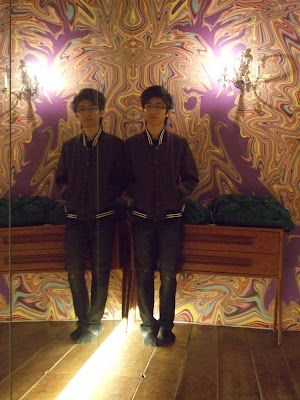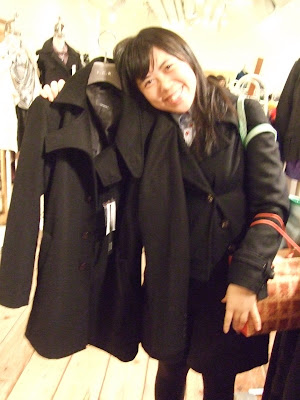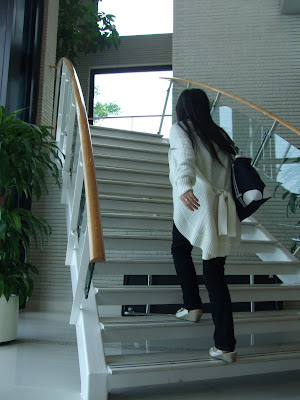Westwood was a
central figure in the London Punk movement in the mid 1970s and has gone from being a subversive shop owner to a pillar of the British fashion establishment. As an independent female in a highly competitive industry she has survived without compromising her ideals. Her vision has at times been at odds with the rest of the fashion world, yet her work has often been prescient. She has provoked outrage, amusement and ultimately respect. Her overriding gift to fashion is a conviction that
clothing can change the way people think. She once said: 'I
think that the real link that connects all my clothes is this idea of the heroic'. As a self-taught designer, Westwood has brought an utterly original slant to fashion, and been responsible for many fashion ideas that are now taken for granted. Although her clothes are often
revolutionary, she has
embraced traditional British fabrics and materials, and made them her own. While her work in the
1980s, post Punk, was wildly eclectic, the dominant theme of the
1990s was historicism. Westwood is ambitious for her craft. She has great faith in fashion as personal propaganda, as mental and physical stimulation, saying
'clothes can give you a better life'.
Vivienne Westwood was born in Derbyshire in 1941. Her family moved to London when she was a teenager and in 1965 she met art student Malcolm McLaren. Their working relationship lasted from
1970 until 1983, and memorably
launched Punk. Fashion became for Westwood 'a baby I picked up and never put down'. Between 1971 and 1981 the couple ran a shop at 430 Kings Road in London which became the centre of the
emerging Punk movement. The absorption of this outrageous and provocative cultural phenomenon by the mainstream and a growing disillusionment with working on the fringes led Westwood and McLaren to reassess their position. McLaren became
increasingly involved in music although he continued to contribute ideas for their collections. Westwood recalled: 'I didn't know what to do ...
Malcolm said "look at history"'. She began to research in the
National Art Library in the Victoria & Albert Museum, London and
found patterns for 18th-century men's clothing. These formed the basis for the billowing shirt and exaggerated trousers of the colourful, romantic
1981 Pirate collection, their first to be shown on the catwalk. The Pirate collection entered the bloodstream of mainstream fashion immediately. It also came to the attention of the Victoria & Albert Museum curators who acquired the Museum's first outfit from World's End (the many times re-named outlet at 430 Kings Road).
In 1982 Women's Wear Daily described London as 'a teeming fashion market-place buzzing with ideas. They bounce off the streets and out of the prodigious art colleges'. That year Westwood and McLaren launched their second collection,
Savage (Spring/Summer 1982), which featured
geometric American Indian patterns. Although the
balance of Westwood and McLaren's creative partnership was changing, Vivienne still consulted Malcolm. She said at the time: 'He edits my work, sorts out my story, unscrambles my programming and gives me an avenue of approach'. The third collection,
Buffalo (Autumn/Winter 1982–83, also called
Nostalgia of Mud, featured
sheepskin jackets and big swirling skirts. Westwood exhorted her fans to 'Take your mother's old brassiere and wear it undisguised over your school jumper and have a muddy face'. Like many of her fashion ideas, the
bra worn on the outside was soon picked up by other fashion designers. Westwood was now on the Paris fashion circuit and Buffalo was followed by
Punkature (Spring/Summer 1983), a
futuristic interpretation of Punk. It introduced the
tube skirt, one of Westwood's most successful and
commercial designs.
For the next collection,
Witches (Autumn/Winter 1983–84), Westwood incorporated art work by
New York graffiti artist Keith Haring whose work she described as 'a magical, esoteric sign language'. Witches was the first catwalk show to feature
trainers, customised with three tongues. With a rap music soundtrack and strobe lighting, Westwood described the freeze-frame effect of the Witches show as
'like sequences of things, where people are dislocated somehow at the same time that they're moving'.
In 1984 Westwood moved briefly to Italy with her new business partner, Carlo D'Amario (today Managing Director of her company) and most of her 'ready-to-wear' is still produced there today. She designed Hypnos (Spring/Summer 1984) which featured sleek garments made out of synthetic sports fabric in fluorescent pinks and greens, anticipating later trends in sportswear. The Hypnos collection was selected to be shown in Tokyo at Hanae Mori's Best of Five global fashion awards. By the mid 1980s, Westwood's self-taught tailoring skills converged with her increasing interest in British traditional clothing in the humorous Mini-Crini and Harris Tweed collections (Spring/Summer 1985, Autumn/Winter 1987–88) The crini was a short, full skirt with plastic boning, inspired by the 19th-century crinoline and also by a ballet performance which Westwood had seen. She said: 'Even if you're on a crowded tube, it always springs back after being squashed'. For summer, it was made in printed cotton with polka dots and stripes and teamed with cotton twin sets by the long-established British company John Smedley. The winter version was in bright red Harris Tweed, hand-woven in the Western Isles of Scotland. It was worn with a matching jacket with velvet collar, inspired by the traditional double-breasted children's coat. Westwood said 'I'm not really trying to be English — you can't avoid it, it's what you've absorbed. I do have fun knowing that I am doing it. I very much enjoy parody and this English sort of lifestyle ... and I really am in love with the fabrics'. She has continued to draw international attention to British fabrics, including tartan, throughout her career and was awarded the Queen's Award for Export Achievement in 1998. The Harris Tweed collection also launched the corset, which Karl Lagerfeld described as one of the most important fashion ideas of the 20th century.
The next five collections were later known as Britain Must Go Pagan. Westwood explored a diversity of influences, from Sevres porcelain to pornographic Greek scenes. The clothing reflected the inherent contradiction in Westwood's work between
respect for tradition and culture and a love of parody and sexual liberty. She paired classical drapery with Prince of Wales check, Fair Isle sweaters with computer-game patterns, and designed articulated jackets and corsets with removable sleeves, inspired by medieval armour. Precise 'Miss Marple' suits (after Agatha Christie) in thorn-proof Harris Tweed received a fillip with saucy tulle flounces. She teamed Savile Row-style jackets with nude tights with a fig leaf, creating something that shocked even herself: 'When I first did the
fig leaf, in 1989, I just kept screaming. It was porno and so hilariously mad. Then I got used to it, and I think it looks so elegant and ironic'. The style was inspired by the short jackets and flesh-coloured pantaloons of neo-classical menswear. Westwood famously wore this outrageous ensemble to lend support for a strike over the loss of museum staff outside London's Natural History Museum in 1990. Her message was that
culture must be saved.
In the 1990s Westwood gained increasing respect for her work internationally. In October 1991 and 1993 she was named British Designer of the Year and was awarded the OBE by HM the Queen. Westwood began to attract society clients and even came to the attention of Margaret Thatcher who said 'I'm so glad she's British'. The most characteristic aspect of Westwood's work in the
1990s is its
historicism. Her revelation is that
fashion is profoundly enriched by renewal and reinvention, and she believes this to be a radical departure. She once said: 'I am a great believer in copying; there has never been an age in which people have so little respect for the past'. In
Portrait (Autumn/Winter 1990–91) Westwood created one of her richest and most elaborate collections at a time when minimalism was becoming prevalent. Her intention was to suggest that her
models had just stepped out of a painting. She used
rococo designs derived from 18th-century furniture printed in
gold ink on to stretch black velvet and photographic prints of Boucher's paintings on shawls and corsets. Later, her love of painting was expressed in creations that emulated the very quality of the artist's technique, for example in her Gainsborough blouse, its edges gently frayed to suggest fine brushwork, and in sumptuous ball gowns styled in the spirit of Winterhalter. The Victoria & Albert Museum's important collection of 17th-century slashed costume inspired a dynamic collection of hand- and machine-slashed shirts, jeans and even knitwear, while another collection featured jackets in
costly woven silk based on 18th-century 'Spitalfield' waistcoats. Westwood's fascination with English and Scottish traditions — as sources of inspiration and subjects for parody — was celebrated in
Anglomania (Autumn/Winter 1993–94) with mini-kilt tartan ensembles. The Locharron Textile Mill in Scotland
created a special tartan for Westwood called the 'McAndreas'', after Westwood's second husband and co-designer, Andreas Kronthaler. It was in this collection that Naomi Campbell, wearing a royal blue velvet jacket, tartan kilt, tam-o'-shanter and slippery cream rubber stockings, fell from her 10-inch, super-elevated, blue 'mock croc' platforms. These were subsequently acquired by the Victoria & Albert Museum.
The
1990s also saw an increased confidence in tailoring.
Westwood studied the work of the French couturier Christian Dior (1905–1957) carefully, saying 'It's beautiful how Dior adapts the masculine look so wonderfully to the feminine body'. Her
interest in exaggerating the figure was taken to the extreme in collections such as
Erotic Zones (Spring/Summer 1995) with its
padded busts and metal cage bustles. This silhouette was soon accentuated with
upward-sloping shoulders (in a take on power dressing) and exceptionally high concealed platform shoes. This super-feminine look proved particularly challenging to sell, although the press loved it. Westwood saw such outrageously feminine ensembles as empowering, saying 'It's very confrontational somehow. It's
for someone who's a very strong character'.
In her 21st-century collections, Westwood has, for the time being, put historicism aside. Her most recent collections such as Le Flou Taillé (Autumn/Winter 2003–04) and Exhibition (Autumn/Winter 2004) embrace the essential paradox between constriction and freedom through dynamic cut. The work evokes the 'ethnic' cutting which she first explored in the early 1980s, based on squares, rectangles and triangular gussets. The addition of semi-circles and curved seams, inspired by the organic silhouette of animal skins, give fullness to the fabric while skilful, dynamic folding creates air pockets in the fabric. In a recent conversation with the author Westwood held two edges of a sheet of A4 paper together, but not quite aligned, demonstrating how this immediately gave a twisting dynamic to the inert paper, as if she was trying to find another dimension. Westwood said, 'Art must be anchored in technique; this means the manipulation of materials — in my case my materials are essentially the human and cloth. It is my job to make the cloth give expression to the body of a human being. One must constantly judge and manage the detail in terms of the general effect one is trying to create so that the form is the idea: a beautiful form is a beautiful idea — this is design'.
Although Westwood says of Punk, 'I'm proud to have been part of it. It was heroic at the time', she has long since moved on. Her distinctive voice has introduced a startling and highly influential new vocabulary to fashion, characterised by a utopian vision of its potential: 'I would describe it really as a nostalgia for the future'. If you are lucky you may see her cycling past, next time you are in south London, with her wire-haired fox terrier, Alexandria, in the basket. Westwood has never taken the easy route in her life, and has achieved greatness through great effort. She said 'I always try to go a different way home. It's a kind of curiosity, not to want to do the same thing — Why do we have to do it this way? I'm going to try it that way'.
![[Untitled-9.jpg]](https://blogger.googleusercontent.com/img/b/R29vZ2xl/AVvXsEjUaDHIUmioh86D0hNSNR7PFQZZ8J4Bk72uQdg32-Jzv5AMD1fHfxgtem97xVrFGuW9Q7FVYOoYfTauPv7HxdP2lquTcnp7Rp16CHw3ypsHey-iX23PGdQ0lFiSfELMkUVg3y5h_pKp3YE_/s1600/Untitled-9.jpg) ------->
-------> ![[(VW)Fall+2009+Ready-to-Wear.JPG]](https://blogger.googleusercontent.com/img/b/R29vZ2xl/AVvXsEipHsY5cRYxksLGjPWr3Q0WoToN2WpKm8mkNqjLjbojh_BP6UnuHrnGswcQNxSoFvpc02bwFmS6u-qFiJrxjF1wvnJ-fmtGOfXSGB1Bo3BF7r-MDYyjjpeiHNgry9c-eL-XCn6ZaUs9Zglg/s1600/(VW)Fall%2B2009%2BReady-to-Wear.JPG)
![[未命å 99.bmp]](https://blogger.googleusercontent.com/img/b/R29vZ2xl/AVvXsEhuRmMK4UF5PBLagJkAJF5e2xB8olsvbrBszlzbGoyryXHysWavA6WOGxrKceNccVfsK_DegVPVqREvQqRje0kQSv8mzvDw72k4-9leAeezgM4igpPC8pjeTGmYFSTEzIX4y_37r-iQzmdJ/s1600/%C3%A6%C5%93%C2%AA%C3%A5%E2%80%98%C2%BD%C3%A5%C2%90%C2%8D99.bmp)
![[Untitled-5.jpg]](https://blogger.googleusercontent.com/img/b/R29vZ2xl/AVvXsEhM-uhD5X6PtDsgvniw0kXqOW5ZlMRQ4LqC9PjQX74Dov9YJA_aLeL8F_2JlXsBKpabBSlpTuHfmYxXu9Qby1jbekzccY_TuRNdciGp8rijH4m9J2o__qzX7rlQR4OinmNgBcPl1bB58uaV/s1600/Untitled-5.jpg)
![[AutumnWinter_2008-2009_Ready_to_Wear.JPG]](https://blogger.googleusercontent.com/img/b/R29vZ2xl/AVvXsEj6cCJrYLJB72CxPhBgHQjYaj0LPBdPLbRywm5uSiHwlf2xoc4bWsoQarGxQ9jEztzB8z0LBtpLdQkH4If4VY6pr-poH-Q2zSXGs9HnuipGRMC1NGKIe1GYCn1hD7WYcVAy9BfYihk-xeY/s1600/AutumnWinter_2008-2009_Ready_to_Wear.JPG)




























 Some Background:
Some Background: 










